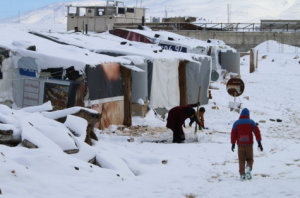With the refugee crisis in Europe deepening, there are thousands of refugees across Europe that are currently homeless. Since this influx is a fairly recent phenomenon, the elements have yet to pose a problem. However, that could change soon; I recently came across an article that discusses the problem the upcoming winter could pose for refugees. UN figures reveal that a record-breaking 218,000 refugees made the crossing into Europe last month, confirming that the end of summer has had no adverse effect on the flow of refugees.
The numbers of people arriving at the same time that winter is coming is  raising fears of a new humanitarian crisis within Europe’s borders. Last week, a summit of EU and Balkan states agreed to some measures of extra policing and shelter for 100,000 people. Yet still an estimated 700,000 refugees and migrants have arrived in Europe this year from Syria, Eritrea, Afghanistan, Iraq and North Africa, among other places. Countless numbers are still homeless, and accompanying cold spells and shortening nights are a bad sign of things to come. While refugees have escaped war and famine, many of them are currently at risk of hypothermia, pneumonia and other diseases. Fights have been breaking out over blankets, occasionally between different national groups.
raising fears of a new humanitarian crisis within Europe’s borders. Last week, a summit of EU and Balkan states agreed to some measures of extra policing and shelter for 100,000 people. Yet still an estimated 700,000 refugees and migrants have arrived in Europe this year from Syria, Eritrea, Afghanistan, Iraq and North Africa, among other places. Countless numbers are still homeless, and accompanying cold spells and shortening nights are a bad sign of things to come. While refugees have escaped war and famine, many of them are currently at risk of hypothermia, pneumonia and other diseases. Fights have been breaking out over blankets, occasionally between different national groups.
The UN refugee agency UNHCR is distributing outdoor survival packages, including sleeping bags, blankets, raincoats, socks, clothes and shoes, although the number of people they can reach is limited by funding, which has proven scarce. Europe is currently dealing with the largest refugee influx since World War II, and is ill-prepared. The EU is hurriedly improvising new mechanisms to respond as a continent, although whether or not they can do it in a timely fashion remains to be seen.
While many guessed that the number of refugees crossing into Europe would slow with the start of winter, as it had in previous years, but it doesn’t show any signs of stopping this year. Most migrants arrive via Lesbos, a Greek island near the coast of Turkey, and from there cross into continental Europe. According to Kate O’Sullivan of Save the Children, colder weather will not only make crossing into Europe more dangerous, but also make conditions inside the camps more dangerous. Many of the refugees are from warmer-weather countries, and have never experienced a winter before, so how they will be able to handle a European winter remains to be seen.
